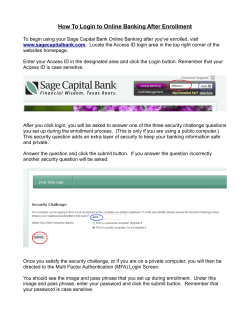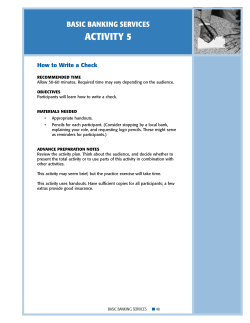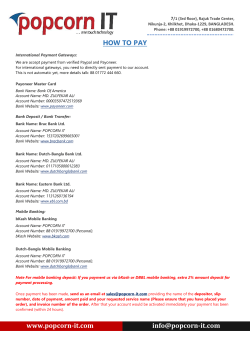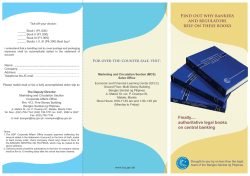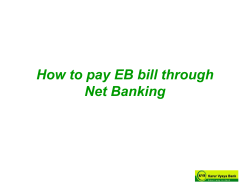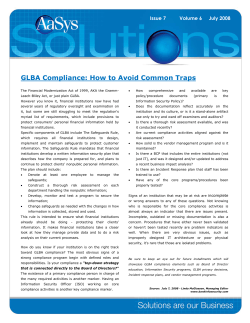
FREE SAMPLE PROFILE
FR EE PR SA OF M IL PLE E Welcome to the new 7th Edition of the Retail Banking Systems (RBS) Market Report from IBS Intelligence. At IBS, we prefer to let the quality of our content speak for itself. So we have produced this special brochure featuring extracts from a sample supplier profile, to show you just how in-depth and valuable a copy will be for you and your team. The latest edition of the Retail Banking Systems (RBS) Market Report brings you right up to date with the leading retail and universal core banking offerings. Totally independent, in-depth and updated, it provides a huge amount of information on each supplier and its systems. That information, as with all IBS Intelligence publications, stems from our investigative reporting, not from supplier hype. The Report has input from users of all of the systems and highlights their strengths and their weaknesses, their successes and failures. The RBS Market Report, Edition 7 will be indispensable if you are engaging in any of the following: ❏ ❏ ❏ ❏ ❏ ❏ ❏ ❏ Entering into systems selection Defining a fully audited longlist/shortlist Constructing an RFI and/or RFP Comparing what is available on the market Vendor due diligence Evaluating system functionality and technology Researching the retail and universal banking systems market Competitor analysis. See for yourself with the sample content enclosed. Bibliographic information Publication date: October 2010 A4 size, 800 pages ISBN 978-1-904778-59-2 Available in Print, Digital Edition and in IBS eLibrary formats. Print: £895 / $1340 / e985 Digital Edition: £895 / $1340 / e985 Print & Digital (order both formats and save 30%): £1253 / $1875 / e1375 Order online at www.ibsintelligence.com Fax or Post your order using the priority order form on the reverse of this sample Contact our customer hotline: +44 (0)1303 262 636 Email: publications@ibsintelligence.com 2 | Extracted from the new 7th edition of The Retail Banking Systems Market Report © 2010 IBS Intelligence © 2010 IBS Intelligence www.ibsintelligence.com CALLATAY & WOUTERS COMPANY DETAILS Head Office Tervuren Plaza – Av. de Tervuren 226, B–1150 Brussels, Belgium. Tel: +32 2 777 41 11. Email: company@cw-thaler.com Other Offices Dubai, Paris, Jakarta, London, Luxembourg, Singapore, Geneva, Amsterdam, Moscow, Frankfurt, Sydney, Beijing. Website www.cw-thaler.com Contact Johan Martens, Sales & Marketing Director. Founded 1983. Ownership The founders own 56 per cent, institutional investors 39 per cent, management five per cent. Number of Staff 500. Financials Turnover for 2009 was E68.2 million, a one per cent increase compared with E67.8 million in 2008. Operating profits for 2009 were E3.5 million compared with E2.2 million in the previous year, representing an increase of 62 per cent. Turnover for 2007 was E57.4 million; turnover for 2006 was E46.4 million. Origins The Thaler system from Brussels-based Callataÿ & Wouters (C&W) is primarily a retail and private banking back office solution, although some treasury support has been added. There are complementary data warehouse and e-banking offerings. Its progress has been steady since it was launched in the mid-1990s, with an acceleration of activity in the last few years, including a broadening of its geographical base. Long-standing recruits include a group of subsidiaries of ING Bank, Banque de la Poste, and the UK’s National Savings Agency. A notable first sale was gained in Singapore in May 2002, in the form of Rabobank, with further inroads in Asia Pacific since then, notably at Commonwealth Bank of Australia. Another notable user is RaboDirect, with Thaler underpinning this entity, and the company has also moved into central Europe and Islamic banking of late. C&W was set up in 1983 by Didier de Callataÿ, an ex-banker, primarily with Royal Bank of Canada, and Godefroid de Wouters, who previously worked for another software house, CIG, as well as for Euroclear. The company took a well-trodden route by starting with a focus on consultancy and bespoke development projects, with the expertise gleaned from these fed into a generic system. Consulting assignments were carried out at Générale de Banque, Crédit Communal, Nagelmackers, Puilaetco, and Banque Commerciale Zairoise. In 1985, there were system development projects at Petercam and Comptoir d’Escompte de Belgique. Two early projects in particular contributed to the Thaler design, at Société Générale in Brussels and Central Hispano Benelux. The percentage of the company’s revenues from services has gradually decreased. Software licences contributed only five per cent of income in 2000, rising to twelve 3 | Extracted from the new 7th edition of The Retail Banking Systems Market Report © 2010 IBS Intelligence © 2010 IBS Intelligence www.ibsintelligence.com per cent in 2001. Today, while there is still a services part to the company’s revenue, most of this is Thaler-related. The origins of Thaler can be found in a three year project which started in 1989 at Caisse Privée Bank. A system was built here which ran on a Bull mainframe and was written in Cobol. At least some of the design was centred on the work at Central Hispano (effectively the old operation of Continental Illinois) and SocGen. Defined within these projects were client structures, account structures, and messaging. The resultant system went live in 1992 and spanned private and retail banking. Orders followed from Banque SEFB – at this time part of the Banque Brussels Lambert group – and Crédit Professionnel. These projects ran from 1990 to 1994. In 1993, C&W set about developing a non-Bull version of the system. The first taker was Fortis Bank in Luxembourg. The supplier claimed that the original version had a layered architecture which meant that the application code was separate from the platform dependent code. As a result, C&W was able to come up with a second version of the system running on Unix servers, with Windows or Windows NT clients. This version was installed on the Unix platforms of IBM and Bull (effectively both IBM’s RS/6000), Hewlett-Packard’s HP-UX, Siemens and Sequent. The port to the latter supposedly took a day and a half. Version 2 of the system used a transaction processing monitor, in the form of BEA’s Tuxedo, and was ODBC compliant, allowing it to support Oracle, Informix, DB2 and others, as well as C-Isam files. In parallel, the system was turned into a more packaged offering, with C&W enhancing the management of releases, maintenance and support, documentation and training. Given the layered architecture, C&W claimed it would be relatively easy to add server support for Windows NT or for a TP monitor other than Tuxedo if there was the demand. The system was officially launched as Thaler in 1995. A ‘Thaler’ was an old German silver coin, first minted in 1518. It remained in circulation until the late 19th century and gave rise to the word ‘dollar’. The name was registered as a trademark by C&W. Functionality As befits a system with such origins, Thaler was built around the customer. It is not object oriented as such, but does include a fair amount of reusability. Programs are relatively small and are linked by tools within an overall framework. User or country specific programs can be slotted in and called without impacting the core. Parameters are used to define conditions and tariffs, reports, document layout and screens, as well as client specific routines. In total, there are 400–500 tables within the system. There are four parts to the architecture – basic data, bank products, management of the bank, and infrastructure. Basic data includes information on all third parties, conditions and tariffs, and credit lines. The bank product element is the core processing engine, with the resultant data passed to the management domain. The infrastructure element includes the platform dependent features. There is a separate messaging component for incoming and outgoing communications. General functions are held centrally and reused when needed. They include routines for tasks such as interest calculations, schedule management and so on. Thaler comes with toolsets comprising program generators, a pre-compiler, screen generator (the system ran in a pseudo graphical user interface environment before a full GUI front-end was added in 2000), database management tools, a data dictionary, document generator, menu definition tool, and configuration management tool. The system is multi-lingual and most of the updating is intended to be in real-time, with relatively little batch processing. A euro working party was set up in mid-1996, with a euro compliant version of Thaler delivered around one year later. A ‘Thaler Euro Kit’ module contained tools to allow accounts and contracts to be converted. The underlying platform is now described as the FS Banking Data Integration Layer and is positioned as the basis on which banks could build their own solutions. At the same time, C&W provides its own ‘solution packages’ on top of this. There is coverage for current, savings and cash accounts. For payments, Thaler spans transfers, standing orders, 4 | Extracted from the new 7th edition of The Retail Banking Systems Market Report © 2010 IBS Intelligence © 2010 IBS Intelligence www.ibsintelligence.com cheques, direct debits, cards, international payments, and clerk and agency operations. It supports term deposits and cash certificates, and a range of loans. It also covers securities, in terms of client portfolios, stock exchange orders, securities transactions, and asset management. Thaler does not include its own retail teller front-end but has been interfaced to Banksys in Belgium and Bancomat in Luxembourg. The system has been interfaced to a range of third party systems, including the FRS-derived Abacus for statutory reporting, SAP’s R/3 general ledger, the Management Data-derived reconciliation products, and Siebel CRM platform. Fortis Bank in Luxembourg was an important source of joint development. As stated, the bank was the first to take the Unix version and went live in 1995. The system here was subsequently broadened so that the bank came to use Thaler to support most of its retail banking business in this country. In 1998, the bank linked Thaler to an in-house developed internet-based solution for its retail customers. Within the coming together of Fortis and Générale de Banque, Fortis Luxembourg remained intact as a retail and private banking specialist. The treasury element covers FX, MM, swaps, FRAs and options. It went live at San Paolo Bank in Luxembourg in November 1998 to replace Midas. The design started within C&W as a generic project prior to the recruitment of this first taker. Programming commenced around March. The second phase, in 1999, brought support for additional derivatives instruments and an interface to an investment funds system from Sungard. Clearly, San Paolo was not a high volume taker although, as will be seen below, Thaler has been benchmarked for general high-end processing. No additional pure treasury related sales have been made, and even San Paolo was relatively oriented towards private banking as opposed to pure wholesale. Nevertheless, a number of subsequent takers do use the treasury support, including Mizuho. To try to raise its profile in the international banking sector, C&W even toyed in the past with coming up with a separately branded version of Thaler. The original takers of the Bull version remained as users. In 1995, the Unix version was sold to Banque Belgolaise. This took the source code and decided to adapt the system itself for roll-out in London, Paris, and 20 locations in Africa. The next taker, in 1996, was De Vaderlandsche Spaarbank in Antwerp, part of the ING Group, followed by Banque de la Poste. Deals in 1997 stemmed from Argenta Spaarbank (in a project headed by EDS), Anhyp-Immobank (which saw the addition of support for syndicated loans but later dropped off the user list after it became part of AXA), and Antwerp-based shipping industry specialist, Creditmar (which became Naviga and then Ethias Bank)... ...continues for a further 4 pages A Broader User Base By the middle of 2001, Robeco, a subsidiary of Rabobank, had commenced implementation of Thaler. Robeco used ERI Bancaire’s Olympic in around six sites and initially looked at taking this for its push into Belgium but was supposedly deterred by the cost of making the country-specific changes. This was the site where Thaler had been linked to Siebel, with a proof of concept of this having been one part of the evaluation. The integration was via Tuxedo. The bank hoped to be live with the system by the start of 2002, and this was achieved. However, there looked as though there might be a complication as Rabobank’s international private banking operations were acquired by Bank Sarasin, to create Bank Sarasin-Rabo, with the Dutch bank taking a stake in the parent. Bank Sarasin had just signed to take the Avaloq system from the Swiss supplier of the same name, with the contract extended to include the expanded 5 | Extracted from the new 7th edition of The Retail Banking Systems Market Report © 2010 IBS Intelligence © 2010 IBS Intelligence www.ibsintelligence.com international operations. As will be seen, C&W has made further inroads although the situation was not clear cut. In terms of geographical expansion, C&W said it would focus on an initial ten or so countries in Europe. It held discussions with potential partners in Spain, Portugal, and some central European countries. It also responded to RFIs from elsewhere. For instance, in mid-1998, Thaler was being bid at a bank in Tunisia but there was no resultant order, with the bank in question taking Oracle Financials. At around the same time, Thaler was bid with EDS at the aforementioned Bank Rozwoju Eksportu but, in the end, the bank opted instead for the Altamira (now Alnova) mainframebased offering from Andersen Consulting (now Accenture). C&W also cited the UK as a target, probably working with a partner. In fact, this hope was realised in early 1999 through a deal with the government-owned National Savings Agency (NSA). At the end of 1998, the government announced the largest outsourcing deal in Europe at this time within the financial services sector. This was with Siemens, and saw 4000 staff move across to the supplier. Part of the deal was an overhaul of the Agency’s systems. In the first quarter of 1999, Thaler was chosen by Siemens to handle a single initial area of the business, the processing of Individual Savings Accounts (ISAs). The system went live, with limited changes, in April. The project took ten weeks and saw C&W contribute a six person on-site team. The requirements of National Savings were not dissimilar to those of Banque de la Poste in Belgium. The foothold gained by Thaler within NSA has been built upon. In late 1999, work commenced to bring other products off of NSA’s old in-house systems and onto Thaler. The next product was FISB, a form of bond. Savings accounts and bonds are NSA’s main product types so the hope was that once FISBs had been defined, adding support for other savings and bond products would be eased. This hope was realised, with work for premium bonds and savings certificates kicking off in 2000 and into 2001. By early 2000, there were 16 full-time C&W staff working on the project, and the supplier had created a separate legal entity in the UK. By the end of the year, the number of C&W staff on site had grown once more, this time to 30. Separately, Siemens was implementing an Oracle-based CRM solution. There were major management changes within Siemens during 2001 and into 2002 which slowed the progress at NSA. However, activity resumed around June 2002 by which time it had been decided to streamline NSA’s systems, with Thaler becoming the main focus. This was not a bad result for a system initially taken as a stop-gap for ISAs. National Savings & Investments (NS&I), as it has become, now uses Thaler for fixed rate savings bonds, savings certificates (this was the first really large product moved to the system), income bonds, pension-guaranteed home bonds, guaranteed equity bonds, and capital bonds. A number of legacy systems have been switched off, with NS&I benefiting from having a standard and more flexible platform... ...continues for a further 8 pages Product Roadmap and SAP Relationship On the product front, by the end of 2005 C&W had moved beyond the evaluation stage with Java and had come out with a roadmap for Thaler. This embraced a Service Oriented Architecture (SOA) model, with the first step being to come up with a Java-based layer in front of the Cobol-based business logic to allow services to be called from here. The supplier said that, over time, the business logic itself would be gradually rewritten. By mid-2007, the project had been dubbed jThaler and had moved on a fair way. Head of research, Pierre-Philippe 6 | Extracted from the new 7th edition of The Retail Banking Systems Market Report © 2010 IBS Intelligence © 2010 IBS Intelligence www.ibsintelligence.com Bastin, pointed out that Thaler now supported a broad range of banks in terms of size (a small entity such as Robeco Belgium at one end to BNP Paribas at the other) and geography, all off one version. Some work had been done to come up with pre-set versions, such as one for private banking (launched in 2006 as Thaler Wealth Management). While implementations were relatively short, he said, there was room for improvement; the same was true for customisation, maintenance and integration. Where C&W had analysed lost deals, it was often due to architecture and technology rather than functionality, he added – the Cobol and client-server make-up of Thaler. The new version of Thaler was meant to move beyond the current parameterisation, so would shift closer to the business users, with default processes but the ability to readily adapt these. To this end, C&W selected a Business Process Management tool called IntalioBPMS from US-based Intalio. By mid-2007, a proof of concept had been carried out with the tool linked to Thaler – ‘it works’, asserted Bastin. The aim was for a ‘context-aware application’. In terms of business standards, interestingly, C&W was by now part of SAP’s finance sector Industry Value Network (IVN), a grouping made up mostly of banks (20 of the 34 participants at this time) through which SAP was seeking to define generic web services. While clearly to be used by SAP itself, the supplier said from the outset that the initiative was meant to be open, with C&W taking advantage of this. There were regular meetings and workgroups. Bastin likened the SOA situation to that of phones – it would only work if everyone used a similar definition. According to De Groote, the IVN was ‘influencing’ jThaler. He hoped a knock-on benefit might be to make it easier for C&W to sell into the SAP customer base. SOA would create a more competitive world, he predicted, because software could be replaced more readily. The knack for application providers would be to have superior business functionality. Bastin said that, where Thaler version 2 added GUI, scalability, and international support in 2002, the jThaler version, scheduled for mid-2008, would bring SOA, object-orientation, BPM and ergonomic improvements. The size of the undertaking should not be under-estimated, he said. First, there was the architecture and framework, encapsulating all technical elements. This step was completed during the first half of 2007, he said, and a customer had started to use it to build an application on top. This was a Belgian insurance company, Mensura, which was moving from a mainframe application in the area of work accident claims onto the jThaler framework on Unix. Bastin called it a ‘technical project’, with cut-over due in June 2007... ...continues for a further 5 pages New Territories and Other Developments A notable new signing during 2009, taking Thaler into a new area, was Malaysia-based lending specialist, Sabah Credit Corporation. This took Thaler on SAP with C&W’s newly-developed Islamic banking module. The project had reached the UAT stage by October 2009 and the software was expected to go live in early 2010. This was the first win in this country. C&W recognised the growth potential in the region, particularly in wealth management and Shari’a-compliant finance, said Anselm de Souza, C&W’s MD for Asia Pacific. The new Islamic banking module had been developed with Malaysia-based IA Group, a consulting, IT and outsourcing company. The two entities were introduced by SAP. C&W was looking for a partner in Asia to boost its sales and was impressed by IA’s ‘strong team of consultants’, with a Capgemini background and knowledge of technology and banking in the region. 7 | Extracted from the new 7th edition of The Retail Banking Systems Market Report © 2010 IBS Intelligence © 2010 IBS Intelligence www.ibsintelligence.com Sales by Year 2004-2009 and by Region 8 7 6 5 4 3 2 1 The discussions led to the decision to develop an Islamic banking solution, using C&W’s platform and methodology and IA’s expertise in Islamic finance and large-scale implementations in the region. The result, dubbed Thaler Islamic Banking Solution, is targeted at top-tier state and private banks in Malaysia, Indonesia and other countries in the area. It is not aimed at smaller banks, cooperatives and microfinance institutions, stated de Souza, although Sabah Credit itself is a fairly small player. 0 While coming at the Islamic banking market later than most, de Souza claimed that the Islamic version of Thaler was different from similar products in the market. Rather than tweaking conventional modules and customising some of the system’s pieces to make them Shari’a-compliant, C&W had invested heavily in R&D to develop a fully-fledged Islamic banking module, he said. To start with, the vendor attempted to do it by itself with some help from external consultants, but felt it was not the right course of action. Thus, a partnership with an expert in the Islamic finance field was deemed a better route. Both parties were working on the project in Malaysia, with IA leading the implementation. The system was already being offered to other banks in the country, said de Souza, at the time the deal was announced, with a number of RFPs and negotiations under way. The companies forecast around $29.6 million worth of deployments in three years. De Souza pointed out that the ultimate aim was to widen the geographical scope, to cover Europe and the Middle East. Also notable in 2009 was a win from Eurasian Bank in Kazakhstan because it was the first, rather long-awaited success via R-Style Softlab. Thaler will support Eurasian Bank’s retail activity across 18 branches and 40+ offices, and will replace some of R-Style’s modules, which perform poorly, particularly in the lending area, said Larisa Kolesnichenko, the bank’s acting director... ...continues for a further 3 pages Conclusion The Thaler customer base has steadily expanded from its original Belgian slant. The company has moved into Luxembourg, France and the UK. The slightly more surprising initial success in Asia Pacific at Rabobank was followed up by the successful project at CBA in Indonesia. Overall, C&W has a good track-record and the system looks to be broad in terms of product support. The projects at Banque de la Poste and NS&I have been notable successes. C&W 8 | Extracted from the new 7th edition of The Retail Banking Systems Market Report © 2010 IBS Intelligence © 2010 IBS Intelligence www.ibsintelligence.com has also expanded within existing users (particularly Rabobank and, of late, CBA), suggesting an overall high level of satisfaction with the system. There are now the ASP initiatives in Luxembourg and the Netherlands, the innovative SAP partnership and, more generally, an interesting mix of users, including the two French banks on the mainframe, the first taker in the CIS and the first Islamic banking recruit. While C&W still does not have a particularly high profile, it continues to make progress and has benefited from staying aloof from the upheaval and consolidation in much of the rest of the market. ❏ Thaler User List Number of known users 39 Example customers Argenta Spaarbank (Belgium) Attijariwafa Bank (Morocco) Bank Commonwealth (Indonesia) Banque de la Poste (Belgium) Banque Générale du Luxembourg [BGL] (Luxembourg) BKCP (Belgium) BNP Paribas (France) Commonwealth Bank of Australia (Australia, Malta, Vietnam) Commonwealth Bank of Australia CommSec (Australia) Crédit Agricole (Belgium) Delta Lloyd Bank (Belgium) Dresdner Bank Luxembourg (Luxembourg) EPT [Entreprise des Postes et Télécommunications] (Luxembourg) Ethias Bank (Belgium) Eurasian Bank (Kazakhstan) Fortuneo (Belgium) Krediet Bank (Luxembourg) ...continues. Order the RBS Market Report to see full list Also in the series International Banking Systems (IBS) Market Report, Edition 15 The definitive resource for anyone interested in the leading treasury and capital markets systems. Wealth Management Systems (WMS) Market Report, Edition 1 Covering solutions for both institutional and personal wealth management. Order all 3 Market Reports and save 20%, or any 2 and save 15%. Visit our website special offers for more information or email publications@ibsintelligence.com 9 | Extracted from the new 7th edition of The Retail Banking Systems Market Report © 2010 IBS Intelligence Table of contents Retail Banking Systems (RBS) Market Report – Edition 7, 2011 INTRODUCTION ❏ The Market – Origins and Evolution ❏ Today’s Sector ❏ Geographical Breakdown by Region of Core Banking System Sales SUPPLIER & SYSTEMS PROFILED ❏ Accenture – Alnova ❏ BML Istisharat – ICBS ❏ Callataÿ & Wouters – Thaler ❏ Delta Informatique – Delta-Bank ❏ Fidelity Information Services – Systematics/Corebank/Profile ❏ Fisa – Fisa System ❏ Fiserv – ICBS/Signature ❏ Harland Financial Solutions – Phoenix ❏ Infopro – ICBA ❏ Infosys – Finacle ❏ Infrasoft Technologies – OmniEnterprise ❏ International Computer Systems – Banks ❏ Misys Banking Systems – Equation/Bankfusion ❏ Neptune – Equinox/Rubikon ❏ Open Solutions – TCBS/TCCUS/DNA ❏ Oracle FSS – Flexcube ❏ Path Solutions – iMAL ❏ Polaris Software Lab – Intellect GUB/LaserPanacea ❏ SAB Ingenierie Informatique – SAB2i/Samic ❏ SAP – SAP for Banking ❏ Silverlake Axis – SIBS ❏ Sungard – Symbols/Ambit Core Banking ❏ TCS Financial Solutions – Bancs ❏ Temenos – Globus/T24 ❏ Temenos – TCB INDEX 10 | Extracted from the new 7th edition of The Retail Banking Systems Market Report © 2010 IBS Intelligence Further resources from IBS Intelligence IBS Journal The definitive independent source of news and analysis relating to financial technology. Each month we talk to banking systems and financial technology users about their strategies and experiences; we drill down into the activities and plans of the suppliers; and we ensure that our readers are kept fully informed on all of the industry events and trends. Industry Guides Banking Systems in the Middle East: A Regional Guide Explains the overall roots and make-up of the core banking suppliers and systems in use in the Middle East, as well as providing in-depth analysis of vendor experiences and customer lists across the region. Also available: ❏ IBS Guide to Back Office Systems and Suppliers ❏ IBS Guide to Payments Systems and Suppliers ❏ IBS Guide to Islamic Banking Systems Market Reports Core Banking Systems Market Dynamics Report 2010 Reveals over 1000 ‘on the record’ system deals showing the vendor, system, bank and country of installation for 2006, 2007, 2008 and 2009. Also available: ❏ International Banking Systems Market Report ❏ Wealth Management Systems Market Report Case Studies 30 Case Studies Vol. 1, 2 & 3 Each Volume in this series explores 30 core banking system implementations and evaluates the experiences of a diverse set of financial institutions across the globe, of various sizes and activity. Also available: ❏ The Innovators: Financial institutions that think differently ❏ Corporate Financial Technology 25 Case Studies Analyst Reports Business Intelligence Systems By exploring this often misunderstood area of technology, this report takes an impartial view of its successes and failures, delivering a comprehensive overview of what a BI system really is, and what it can and can’t do. Also available: ❏ Enterprise Risk and Finance Architectures ❏ Customer Centricity Visit www.ibsintelligence.com for more information and to order online. +44 (0)1303 262 636 publications@ibsintelligence.com 11 | Extracted from the new 7th edition of The Retail Banking Systems Market Report © 2010 IBS Intelligence PRIORITY ORDER FORM FAX BACK: +44 (0)1303 262646 POST: IBS Intelligence, 8 Stade Street, Hythe, Kent, CT21 6BE, UK ONLINE: www.ibsintelligence.com EMAIL: info@ibsintelligence.com I would like to order the Retail Banking Systems (RBS) Market Report Edition 7 Format Qty Price Total Print £895 / $1340 / e985 Digital Edition £895 / $1340 / e985 Print & Digital (save 30%) £1253 / $1875 / e1375 Contact details Name Job Title Company Address Postcode Country Tel Email VAT Number Payment details Additional options ❏ I enclose a cheque made payable to IBS Publishing Ltd ❏ Please invoice my company ❏ Please charge my credit card using the details below ❑ ❏ ❏ ❏ Please Please Please Please send send send send my order by courier (see below) me the IBS Catalogue 2010 me new IBS publication email alerts me the free IBS Journal eNewsletter Card type (Visa/Mastercard/Amex) Cardholder Name Address (if different from above) Card Number Expiry Date Security no. - Visa & Mastercard 3 digits on reverse must be provided - Amex 4 digits on back On receipt of your order, we will send out the requested publication(s) along with an invoice/receipt by first class/air mail. If you would like your order to be sent by courier please tick the box above. The courier charge will be added to the amount due for payment. If you would like to pay by credit card you will need to contact us on +44(0) 1303 262636 for the courier charge in your specific location. IBS Intelligence is a trading name of IBS Publishing Ltd, a company registered in England and Wales no. 5365737
© Copyright 2025
